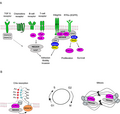| DescriptionFigure 2 NEDD9 mediated signaling.png |
English: A. In cell adhesion, migration, and proliferation control, NEDD9 expression and activity are regulated by multiple upstream inputs. (NEDD9: Neural precursor cell expressed developmentally down-regulated protein 9). Important transmembrane regulators include integrins (Astier, A., et al.,J. Biol. Chem., 1997) and RTKs, the CXC (SDF-1alpha) chemokine receptor (Regelmann, A.G., et al., Immunity, 2006 ), and the T (Malherbe, L.P. and D. Wang,Sci Signal, 2012) and B (Browne, C.D., et al.,Proc Natl Acad Sci U S A, 2010) cell receptors. Cytoplasmic mediators of activation include FAK, Src family kinases and Abl, additional non-catalytic proteins such as NSPs. Through a chain of protein interactions, NEDD9 can impact activity of Ras and Rac, and their downstream effectors that affect cell movement and growth. Transforming growth factor beta (TGFβ), an inducer of epithelial-mesenchymal transition, has been reported to both stimulate NEDD9 transcription and regulate its degradation.
B. A second group of NEDD9 activities involve its interaction with Aurora-A. NEDD9 binds directly to the Aurora-A mitotic kinase at the centrosome, promoting its activity, and mediating G2-M transition (Pugacheva, E.N. and E.A. Golemis, Nat Cell Biol, 2005). NEDD9 also regulates Aurora-A activation at the basal body of cilia, inducing cilia disassembly during early G1 via activation of the tubulin deacetylase HDAC6 (Pugacheva, Cell, 2007). |




